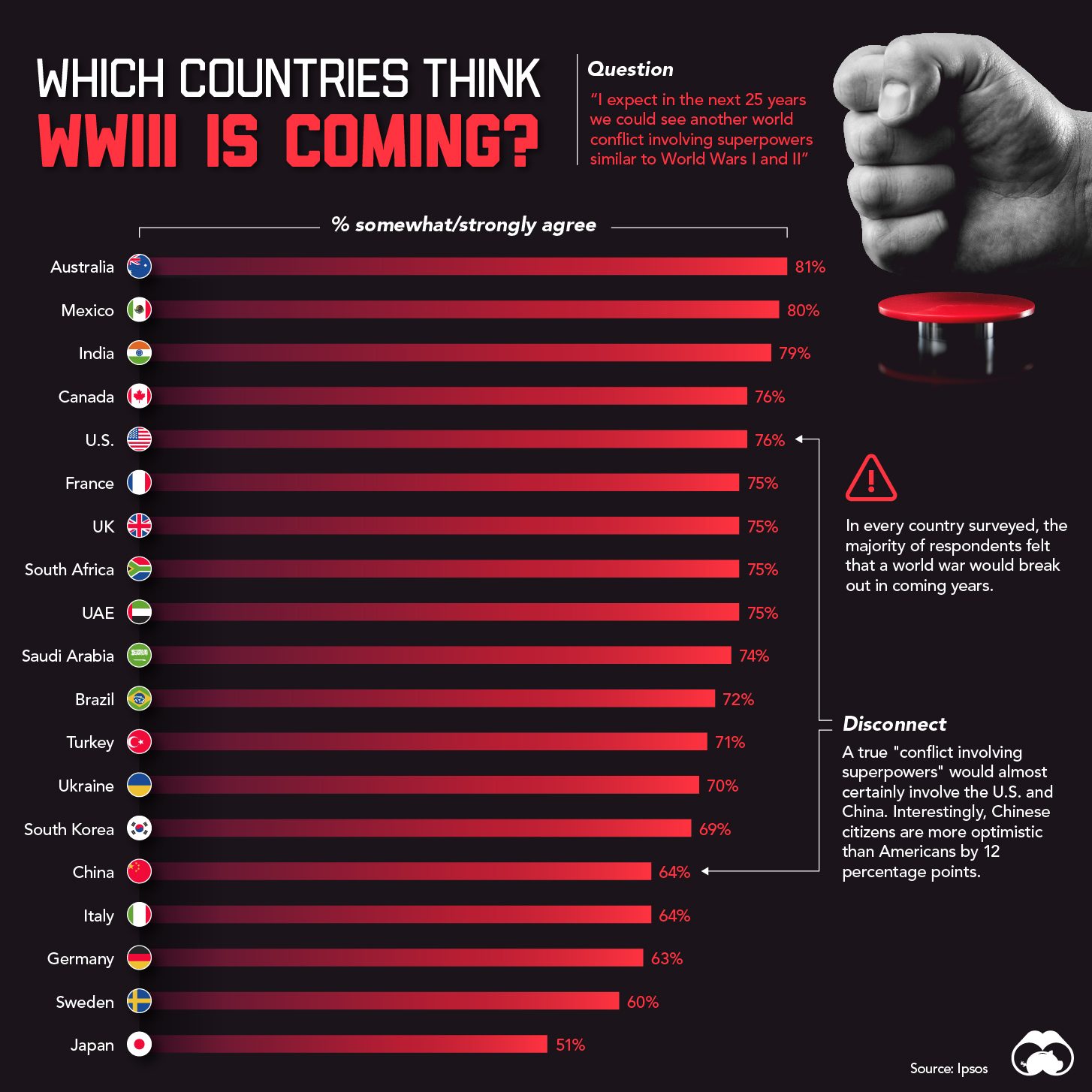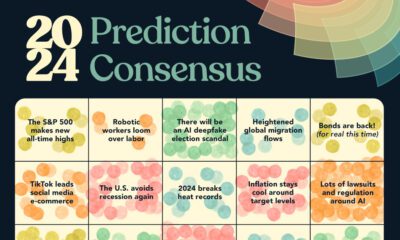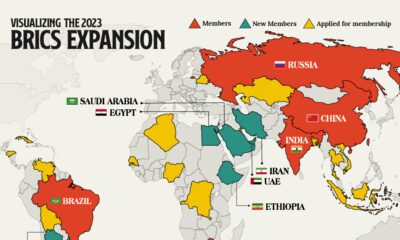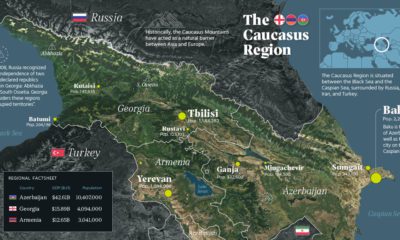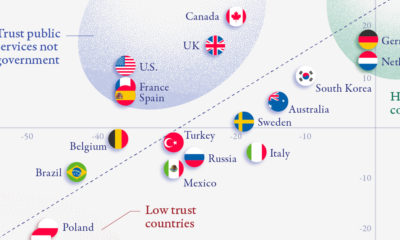Datastream
Which Countries Believe WWIII is Coming?
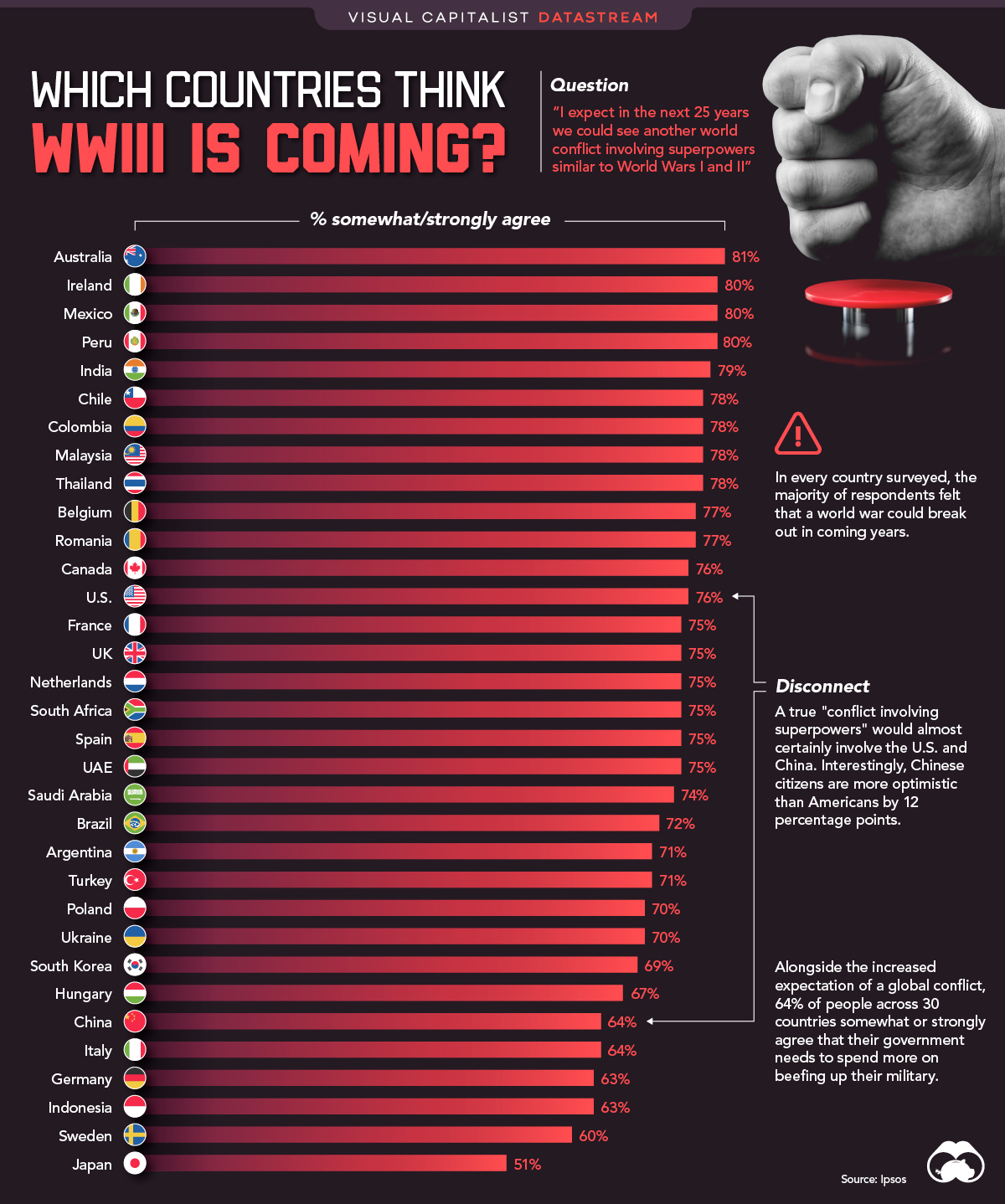
The Briefing
- In every single country surveyed, the majority of respondents believed a world war could break out in coming years
- Australia was the most pessimistic, and Japan was the most optimistic
Which Countries Believe WWIII Could be Coming?
After a pandemic, rampant inflation, a faltering global economy, and geopolitical flare-ups, it’s no surprise that people have a souring outlook on the future.
Even so, the results of this recent survey by Ipsos are eyebrow raising. In all 33 countries where polling took place, the majority of respondents said they believe a world war on the scale of WWI and WWII could break out between global superpowers in coming years.
Here’s a look at how various countries felt about the possibility of an impending global conflict:
| Country | % somewhat/strongly agree | Change from 2021 (p.p.) |
|---|---|---|
| 🇦🇺 Australia | 81% | +8 |
| 🇮🇪 Ireland | 80% | n/a |
| 🇲🇽 Mexico | 80% | +8 |
| 🇵🇪 Peru | 80% | +3 |
| 🇮🇳 India | 79% | +3 |
| 🇨🇱 Chile | 78% | +3 |
| 🇨🇴 Colombia | 78% | +1 |
| 🇲🇾 Malaysia | 78% | +4 |
| 🇹🇭 Thailand | 78% | n/a |
| 🇧🇪 Belgium | 77% | +18 |
| 🇷🇴 Romania | 77% | n/a |
| 🇨🇦 Canada | 76% | +13 |
| 🇺🇸 United States | 76% | +6 |
| 🇫🇷 France | 75% | +16 |
| 🇬🇧 Great Britain | 75% | +19 |
| 🇳🇱 Netherlands | 75% | +15 |
| 🇿🇦 South Africa | 75% | +3 |
| 🇪🇸 Spain | 75% | +5 |
| 🇦🇪 UAE | 75% | n/a |
| 🇸🇦 Saudi Arabia | 74% | +12 |
| Global Country Average | 73% | +10 |
| 🇧🇷 Brazil | 72% | +10 |
| 🇦🇷 Argentina | 71% | +5 |
| 🇹🇷 Turkey | 71% | +8 |
| 🇵🇱 Poland | 70% | +4 |
| 🇺🇦 Ukraine | 70% | n/a |
| 🇰🇷 South Korea | 69% | +17 |
| 🇭🇺 Hungary | 67% | +10 |
| 🇨🇳 China | 64% | +6 |
| 🇮🇹 Italy | 64% | +19 |
| 🇩🇪 Germany | 63% | +17 |
| 🇮🇩 Indonesia | 63% | n/a |
| 🇸🇪 Sweden | 60% | +11 |
| 🇯🇵 Japan | 51% | +16 |
Japan was the least sure of an impending global conflict—an opinion that is almost certainly shaped by the country’s historical experience in WWII.
Australia was the most certain of an impending global conflict. The country has a unique relationship with Asian and Western countries, so geopolitical tensions between superpowers may resonate more in the Land Down Under.
The Power of Fear
Given the negative slant of stories covered by mass media and the types of stories that are most widely shared on social media platforms, it’s easy to understand how people have developed such a gloomy view of the future. But “bad vibes” aside, how could this perception translate into real world action?
For one, public opinion helps shape political priorities. A narrative of impending conflict could have an impact on geopolitical policy and relationships.
Another possibility is an increase in military spending across the board. 64% of people across 30 countries somewhat or strongly agree that their home government should beef up military spending “given the dangers in the world.” Aside from Ukraine, India (84%) and Poland (81%) ranked the highest in support of increasing military spending.
One other noteworthy finding is that 85% of people in the countries surveyed believe that the world needs new international agreements and institutions to deal with the challenges faced by the world today, and that world powers are unlikely to respect agreements made through international bodies. These findings are significant since war becomes more likely as cooperation between countries breaks down.
Where does this data come from?
Source: Ipsos, for Halifax International Security Forum
Data note: These are the results of a 33-market survey conducted by Ipsos on its Global Advisor online platform. Ipsos interviewed a total of 32,507 adults aged 18-74 in the United States, Canada, Malaysia, South Africa, and Turkey, 20-74 in Thailand, 21-74 in Indonesia, and 16-74 in the remaining markets between Friday, September 23 and Friday, October 7, 2022.
Editor’s note: Portions of the graphic and article have been amended to more accurately reflect the phrasing of the poll question. We appreciate the thoughtful feedback we received from our readers.
Datastream
Can You Calculate Your Daily Carbon Footprint?
Discover how the average person’s carbon footprint impacts the environment and learn how carbon credits can offset your carbon footprint.

The Briefing
- A person’s carbon footprint is substantial, with activities such as food consumption creating as much as 4,500 g of CO₂ emissions daily.
- By purchasing carbon credits from Carbon Streaming Corporation, you can offset your own emissions and fund positive climate action.
Your Everyday Carbon Footprint
While many large businesses and countries have committed to net-zero goals, it is essential to acknowledge that your everyday activities also contribute to global emissions.
In this graphic, sponsored by Carbon Streaming Corporation, we will explore how the choices we make and the products we use have a profound impact on our carbon footprint.
Carbon Emissions by Activity
Here are some of the daily activities and products of the average person and their carbon footprint, according to Clever Carbon.
| Household Activities & Products | CO2 Emissions (g) |
|---|---|
| 💡 Standard Light Bulb (100 watts, four hours) | 172 g |
| 📱 Mobile Phone Use (195 minutes per day)* | 189 g |
| 👕 Washing Machine (0.63 kWh) | 275 g |
| 🔥 Electric Oven (1.56 kWh) | 675 g |
| ♨️ Tumble Dryer (2.5 kWh) | 1,000 g |
| 🧻 Toilet Roll (2 ply) | 1,300 g |
| 🚿 Hot Shower (10 mins) | 2,000 g |
| 🚙 Daily Commute (one hour, by car) | 3,360 g |
| 🍽️ Average Daily Food Consumption (three meals of 600 calories) | 4,500 g |
| *Phone use based on yearly use of 69kg per the source, Reboxed | |
Your choice of transportation plays a crucial role in determining your carbon footprint. For instance, a 15 km daily commute to work on public transport generates an average of 1,464 g of CO₂ emissions. Compared to 3,360 g—twice the volume for a journey the same length by car.
By opting for more sustainable modes of transport, such as cycling, walking, or public transportation, you can significantly reduce your carbon footprint.
Addressing Your Carbon Footprint
One way to compensate for your emissions is by purchasing high-quality carbon credits.
Carbon credits are used to help fund projects that avoid, reduce or remove CO₂ emissions. This includes nature-based solutions such as reforestation and improved forest management, or technology-based solutions such as the production of biochar and carbon capture and storage (CCS).
While carbon credits offer a potential solution for individuals to help reduce global emissions, public awareness remains a significant challenge. A BCG-Patch survey revealed that only 34% of U.S. consumers are familiar with carbon credits, and only 3% have purchased them in the past.
About Carbon Streaming
By financing the creation or expansion of carbon projects, Carbon Streaming Corporation secures the rights to future carbon credits generated by these sustainable projects. You can then purchase these carbon credits to help fund climate solutions around the world and compensate for your own emissions.
Ready to get involved?
>> Learn more about purchasing carbon credits at Carbon Streaming
-

 Real Estate2 weeks ago
Real Estate2 weeks agoVisualizing America’s Shortage of Affordable Homes
-

 Technology1 week ago
Technology1 week agoRanked: Semiconductor Companies by Industry Revenue Share
-

 Money1 week ago
Money1 week agoWhich States Have the Highest Minimum Wage in America?
-

 Real Estate1 week ago
Real Estate1 week agoRanked: The Most Valuable Housing Markets in America
-

 Business1 week ago
Business1 week agoCharted: Big Four Market Share by S&P 500 Audits
-

 AI1 week ago
AI1 week agoThe Stock Performance of U.S. Chipmakers So Far in 2024
-

 Misc2 weeks ago
Misc2 weeks agoAlmost Every EV Stock is Down After Q1 2024
-

 Money2 weeks ago
Money2 weeks agoWhere Does One U.S. Tax Dollar Go?




